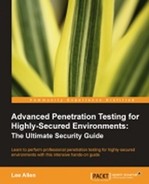Book Description
Learn to perform professional penetration testing for highly-secured environments with this intensive hands-on guide with this book and ebook.
- Learn how to perform an efficient, organized, and effective penetration test from start to finish
- Gain hands-on penetration testing experience by building and testing a virtual lab environment that includes commonly found security measures such as IDS and firewalls
- Take the challenge and perform a virtual penetration test against a fictional corporation from start to finish and then verify your results by walking through step-by-step solutions
In Detail
The internet security field has grown by leaps and bounds over the last decade. Everyday more people around the globe gain access to the internet and not all of them with good intentions. The need for penetration testers has grown now that the security industryhas had time to mature. Simply running a vulnerability scanner is a thing of the past and is no longer an effective method of determining a business’s true security posture. Learn effective penetration testing skills so that you can effectively meet and manage the rapidly changing security needs of your company.
Advanced Penetration Testing for Highly-Secured Environments will teach you how to efficiently and effectively ensure the security posture of environments that have been secured using IDS/IPS, firewalls, network segmentation, hardened system configurations and more. The stages of a penetration test are clearly defined and addressed using step-by-step instructions that you can follow on your own virtual lab.
The book follows the standard penetration testing stages from start to finish with step-by-step examples. The book thoroughly covers penetration test expectations, proper scoping and planning, as well as enumeration and footprinting. You'll learn how to clean up and compile proof of concept, exploit code from the web, advanced web application testing techniques, client side attacks, post exploitation strategies, detection avoidance methods, generation of well defined reports and metrics, and setting up a penetration testing virtual lab that mimics a secured environment. The book closes by issuing a challenge to your skills and ability to perform a full penetration test against a fictional corporation; followed by a detailed walk through of the solution.
Advanced Penetration Testing for Highly-Secured Environments is packed with detailed examples that reinforce enumeration, exploitation, post-exploitation, reporting skills and more.
Table of Contents
- Advanced Penetration Testing for Highly-Secured Environments: The Ultimate Security Guide
- Advanced Penetration Testing for Highly-Secured Environments: The Ultimate Security Guide
- Credits
- About the Author
- About the Reviewers
- www.PacktPub.com
- Preface
- 1. Planning and Scoping for a Successful Penetration Test
- 2. Advanced Reconnaissance Techniques
- 3. Enumeration: Choosing Your Targets Wisely
- Adding another virtual machine to our lab
- Nmap — getting to know you
- SNMP: A goldmine of information just waiting to be discovered
- Creating network baselines with scanPBNJ
- Enumeration avoidance techniques
- Summary
- 4. Remote Exploitation
- Exploitation — Why bother?
- Target practice — Adding a Kioptrix virtual machine
- Manual exploitation
- Getting files to and from victim machines
- Passwords: Something you know…
- Metasploit — learn it and love it
- Summary
- 5. Web Application Exploitation
- Practice makes perfect
- Installing Kioptrix Level 3
- Creating a Kioptrix VM Level 3 clone
- Installing and configuring Mutillidae 2.1.7 on the Ubuntu virtual machine
- Installing and configuring pfSense
- Preparing the virtual machine for pfSense
- pfSense virtual machine persistence
- Configuring the pfSense DHCP server
- Starting the virtual lab
- pfSense DHCP — Permanent reservations
- Installing HAProxy for load balancing
- Adding Kioptrix3.com to the host file
- Detecting load balancers
- Detecting Web Application Firewalls (WAF)
- Taking on Level 3 — Kioptrix
- Web Application Attack and Audit Framework (w3af)
- Introduction to Mantra
- Summary
- Practice makes perfect
- 6. Exploits and Client-Side Attacks
- 7. Post-Exploitation
- Rules of engagement
- Data gathering, network analysis, and pillaging
- Linux
- Putting this information to use
- Enumeration
- Exploitation
- Were connected, now what?
- Which tools are available on the remote system
- Finding network information
- Determine connections
- Checking installed packages
- Package repositories
- Programs and services that run at startup
- Searching for information
- History files and logs
- Configurations, settings, and other files
- Users and credentials
- Moving the files
- Microsoft Windows™ post-exploitation
- Pivoting
- Summary
- 8. Bypassing Firewalls and Avoiding Detection
- 9. Data Collection Tools and Reporting
- 10. Setting Up Virtual Test Lab Environments
- 11. Take the Challenge — Putting It All Together
